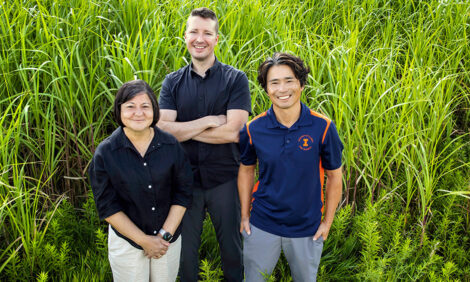



Midwest Winters Challenge Dairy Calf Survival
Making sure calves consume enough feed to meet their maintenance needs and grow is especially important in the winter, North Dakota State University Extension Service dairy specialist J.W. Schroeder says.Sufficient nutrition is one of the most important aspects of winter calf management, says Sam Leadley, a calf/heifer management consultant with Attica (N.Y.) Veterinary Associates. Without proper winter care, including vaccinations and an increase in available feed, calves can fall victim to poor weight gain, disease and even death.
The amount of energy calves need is temperature-dependent. Once temperatures fall below 60 degrees Fahrenheit, calves start burning extra energy just to maintain their core body temperature. For every 1 degree drop in temperature below 50 F, a calf requires 1 percent more energy. By the time the temperature reaches zero, a calf should receive 50 percent more energy (calories) just for maintenance.
“Producers must get enough feed into the calves to meet these maintenance needs,” Schroeder says. “That means extra effort is needed to meet their energy requirements and keep calves healthy throughout winter. A well-managed calf can survive and thrive in cold temperatures.”
However, research suggests only 33 percent of dairy producers change calf-feeding practices in cool weather.
A good rule of thumb is if dairy producers need a sweatshirt when working around their calves, they need to start thinking about increasing calf rations. If the temperature drops to consistently below freezing, bump rations again.
For example, a 100-pound calf at 50 F requires 1.1 pounds of dry matter just for maintenance. That is equivalent to 8.8 pounds, or about 4.25 quarts, of milk. In the case of milk replacer, that is about 0.5 pound of powder mixed to make 2 quarts. For more information, check out tables for specific milk replacers at http://www.atticacows.com in the Calf Facts section.
“If producers only feed the minimum amount, calves will struggle to keep healthy and there will be a surge in mortality, especially among fall- and winter-born calves,” Schroeder says.
According to David Carlson, technical services manager for Milk Products LLC, Chilton, Wis., the cold-weather increase in energy requirements is particularly stressful for calves younger than 3 weeks of age. They are susceptible to cold stress because they consume very little calf starter and have little to no stored fat from which to draw extra energy.
Weight loss will occur if adjustments are not made to the calf-feeding program. The most effective and practical method to increase energy intake during cold weather is to increase the amount of energy offered through the liquid feeding program. Carlson suggests several options, including:
- Increasing the milk replacer powder mixing rate from 8 or 10 ounces to 12 ounces per 2 quarts of total solution fed twice daily
- Feeding an additional pint to quart of milk or milk replacer solution per feeding
- Incorporating a third milk or replacer feeding during the day
- Adding a fat supplement (1 to 2 ounces per feeding) to the milk or replacer diet
These options deliver different amounts of nutrients to the diet and have unique considerations for implementation. Producers should work with their nutritionist and veterinarian to ensure the best option for their operation.
Winter housing also can make a big difference in calf-rearing success.
“You cannot just keep them fed if the environment is not good,” Schroeder says.
A deep bed of long-stemmed straw allows calves to burrow in and preserve body heat. One way to determine proper bedding depth for cold weather is to look at the calf while it is lying down. If you cannot see the calf’s feet, then the bedding is deep enough.
Most everyone has draft-free housing for their calves, but wet bedding can cause problems. Calves have much greater heat loss through wet bedding, compared with dry bedding.
Other practices may include offering warm water two to three times daily to support calf starter intake. As the rumen develops, the calf’s nutrient intake and ability to grow and develop immune functions improve.
Preventing and treating disease also are important to keep calves thriving.
“Cold weather is stressful for calves,” says Tom Van Dyke, manager of Merial Veterinary Professional Services, Duluth, Ga. “That stress leaves calves vulnerable to a host of health problems, including Pasteurella pneumonia, one of the leading causes of bovine respiratory disease.”
According to bovine veterinary practitioners, the most important diseases to vaccinate against include infectious bovine rhinotracheitis, bovine viral diarrhea, parainfluenza-3 and bovine respiratory syncytial virus. Many herds also will benefit from using a coccidiostat and a vaccine to help prevent Pasteurella pneumonia in calves. Producers should watch their calves very carefully for the first sign of respiratory disease.
Disease can progress quickly, and treatment must be done early to be successful. Waiting too long can lead to irreversible lung damage and chronic, or dead, calves. Van Dyke suggests the following guidelines for calf pneumonia prevention:
- Provide well-ventilated facilities
- Keep calves dry and well-bedded
- Feed enough milk
- Avoid nose-to-nose contact
- Keep age groups separated
- Vaccinate dams
- Minimize weaning stress
Van Dyke also advises calves be given a coccidiostat labeled for prevention and treatment of coccidiosis. If not treated 12 to 21 days after infection, coccidiosis causes dramatic clinical signs, such as diarrhea, inability to absorb nutrients, depression, weight loss, secondary infections and sometimes even death. Van Dyke says that once clinical signs of coccidiosis appear, much of the damage already has been done and a preventive strategy is best.
January 2009


